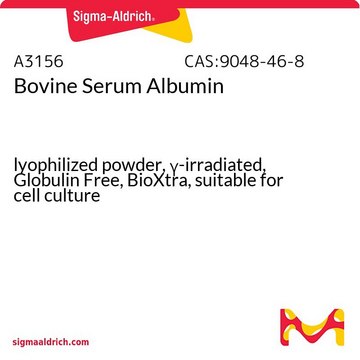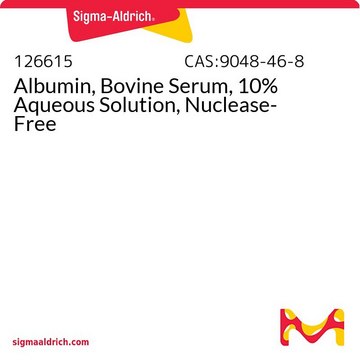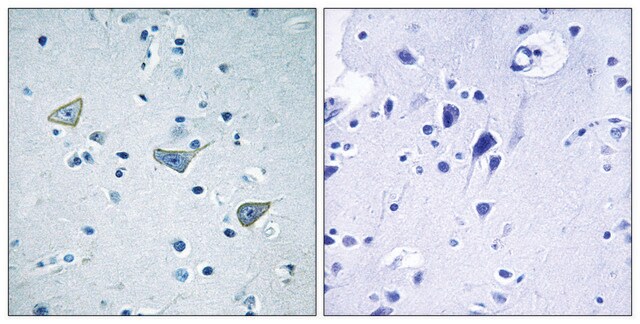A7979
Albumin -Lösung
35% in DPBS, sterile-filtered, BioXtra, suitable for cell culture
Synonym(e):
Albumin -Lösung aus Rinderserum, BSA-Lösung
About This Item
Empfohlene Produkte
Biologische Quelle
bovine
Beschreibung
endotoxin tested
Sterilität
sterile-filtered
Produktlinie
BioXtra
Assay
33-37% total protein basis (UV)
Form
liquid
Ursprung
USA origin
Konzentration
35% in DPBS
Methode(n)
blocking: suitable
cell culture | mammalian: suitable
Verunreinigungen
≤1000 EU/mL Endotoxin level
pH-Wert
6.5-7.5
Fremdaktivität
Mycoplasma Test by Barile On raw material, none detected
Versandbedingung
ambient
Lagertemp.
2-8°C
Allgemeine Beschreibung
Anwendung
Lagerklassenschlüssel
10 - Combustible liquids
WGK
WGK 1
Flammpunkt (°F)
Not applicable
Flammpunkt (°C)
Not applicable
Persönliche Schutzausrüstung
Eyeshields, Gloves, multi-purpose combination respirator cartridge (US)
Hier finden Sie alle aktuellen Versionen:
Besitzen Sie dieses Produkt bereits?
In der Dokumentenbibliothek finden Sie die Dokumentation zu den Produkten, die Sie kürzlich erworben haben.
Kunden haben sich ebenfalls angesehen
Artikel
This page segues to comprehensive insights on how serum albumin and other important cell culture components affect the performance of serum-free cell culture systems used for biomanufacturing heterologous proteins including monoclonal antibodies. The page introduces the in vitro chemistry and biochemistry of albumin. These insights may also be applied to ex vivo and tissue engineering applications.
Unser Team von Wissenschaftlern verfügt über Erfahrung in allen Forschungsbereichen einschließlich Life Science, Materialwissenschaften, chemischer Synthese, Chromatographie, Analytik und vielen mehr..
Setzen Sie sich mit dem technischen Dienst in Verbindung.





